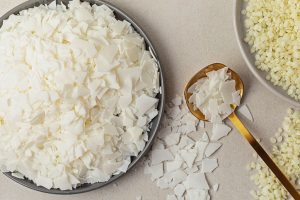What is Bitumastic: Uses, Specifications, and Installation Tips
What is bitumastic and what is it used for? If you are looking for an effective solution for insulating and sealing your construction projects, you’ve probably come across bituminous mastic (also known as bitumastic). This flexible, paste-like material is highly resistant to water, moisture, and even chemicals, and it can be applied using either hot or cold methods. As a sealant, asphalt mastic is widely used for insulating, sealing, and waterproofing concrete and metal surfaces. It also enhances adhesion, flexibility, and resistance to moisture and chemical exposure.
On the other hand, bituminous mastic, with its flexible and durable structure, is suitable for filling joints, cracks, and expansion gaps in construction projects, bridge building, airport runways, and tunnels. This type of mastic comes in various forms that are selected based on different environmental conditions, project type, and application methods. In this article from the Iran ETrade blog — an expert reference for bitumen pricing — we will explore what asphalt mastic is, its different types, uses, and how to apply it.
What is bitumastic?
Bituminous mastic is a type of waterproofing and sealing material produced from bitumen base.
What is bitumastic? Bitumastic is a type of joint filler that engineers mainly use in civil and construction projects. Bitumastic’s main purpose is to prevent the penetration of water, moisture, and chemicals into joints or surfaces with cracks and fractures.
High resistance to environmental conditions, flexibility, and strong adhesion to concrete, metal, and asphalt surfaces are also among its key advantages and features.
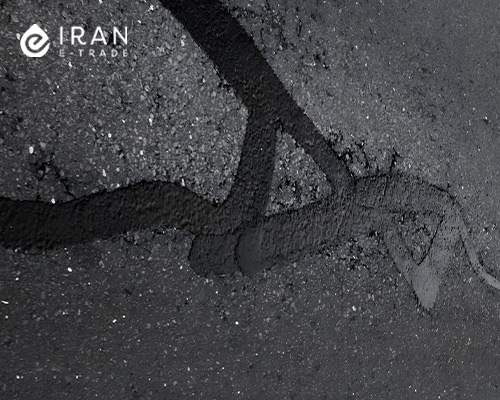
Types of Mastic
What is asphalt mastic? It is a bitumen-based sealant with high adhesion and elasticity, used in many construction and civil engineering projects for insulation and waterproofing.
Various types of mastic have uses in the construction industry and each type has its own advantages and disadvantages. Therefore, to avoid negative consequences, you should choose the mastic that is suitable for your specific needs and application.
The types of mastic include: bituminous mastic, polyurethane mastic, acrylic mastic, silicone mastic, polysulfide mastic, and hybrid mastic, which we will explain below.
1. Polyurethane Mastic
Polyurethane mastic is a strong single-component mastic based on polyurethane that has high elasticity and adhesion. This product is suitable for sealing surfaces that undergo movement and deformation, such as expansion joints in bridges and flooring, and it is even useful for sealing drinking water tanks.
This type of mastic creates durable bonds between different materials and joints to prevent liquids and other substances from mixing with each other.
Polyurethane is also resistant to abrasion and has flexibility compared to many non-waterproof sealants and is generally not paintable. However, to match the colors of concrete and flooring, they are produced in various colors such as grey, black, or white.
2. Acrylic Mastic
This type of mastic is water-based and environmentally friendly. It is also paintable and suitable for indoor spaces as well as sealing walls and windows.
Acrylic mastic is not suitable for areas in constant contact with water. Note that acrylic mastic is less flexible than other mastics and may crack over time if the surfaces move.
3. Bitumastic
What are the uses of asphalt mastic? These uses include: Insulating, sealing, and waterproofing concrete, metal, and asphalt surfaces; filling joints, cracks, and expansion gaps in construction projects, bridge building, airport runways, and tunnels.
Bitumastic, is a single-component elastic filler containing bitumen-based solvents and is useful for insulation, waterproofing, and filling structural joints. It is also resistant to moisture, UV radiation, and chemicals.
These properties make bituminous mastic suitable for final construction operations, waterproofing, bonding, and processes that require quick setting. You can also apply it on damp surfaces and it is paintable. If you are interested in the latest bitumen prices, you can visit the Iran ETrade website.
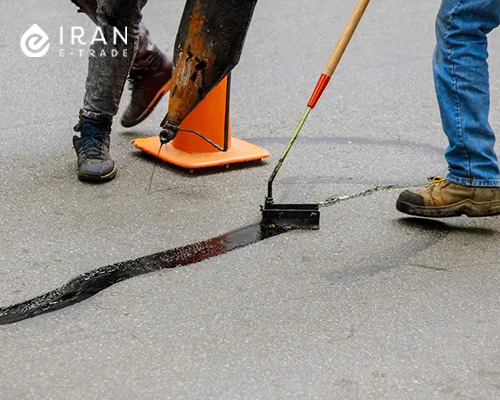
4. Silicone Mastic
Silicone mastic is one of the best types of mastic due to its features. This product maintains its elasticity for a long time and is highly water-resistant.
Silicone mastic is mostly useful in industrial and electronic projects and has high heat resistance. It is also suitable for sealing joints in wet areas like bathrooms and kitchens because it leaks less compared to other sealants and adheres to almost any surface.
Furthermore, silicone mastics do not have issues such as mold growth, rusting, or penetration of liquids and airflow.
5. Polysulfide Mastic
What are the advantages of asphalt mastic or asphalt mastic? Resistance to water and moisture, chemicals, and sunlight, adhesion to various types of surfaces, elasticity, affordable price, creating a uniform coating, and suitability for use on moving surfaces are among the benefits of using bituminous mastic.
Polysulfide mastics contain more volatile organic compounds compared to other types of mastics and generally have limited paintability. In addition, polysulfide mastic remains highly flexible throughout its use and is even applicable on underwater surfaces.
Due to its high resistance to chemicals, it has various uses in many industrial environments such as fuel tanks and industrial structures.
Furthermore, the properties of polysulfide mastic make it a suitable choice for active leaks that require immediate repair and some polysulfide mastics can last up to 20 years.
6. Hybrid Mastic
Another type of bitumastic is hybrid mastic, which has the advantages of both polyurethane and silicone mastics and is environmentally friendly and odorless.
Hybrid mastic adheres to heavy building materials without the need to be fixed to them. Like polysulfide mastic, it is applicable underwater, has strong adhesion and is paintable.
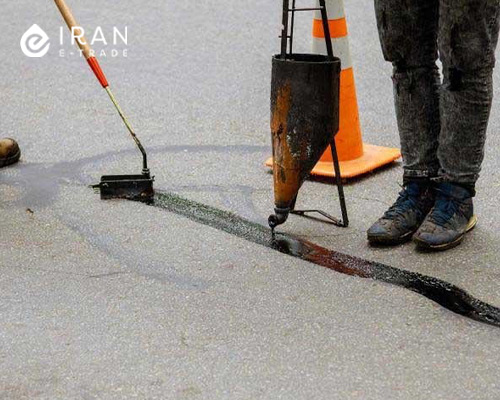
Types of Bitumastic
You can use asphalt mastic in two ways: hot and cold. Cold mastic is a ready-to-use sealant, while you have to heat hot mastic indirectly before use.
In the previous section, we learned what asphalt mastic is and its applications. In this section, we will explain the bitumen joint fillers that are available in two forms: hot and cold. Cold and hot mastic each have different uses and application methods, which we will discuss below:
1. Cold mastic
Cold mastic is an elastic, paste-like sealant that is ready to use. Once dried, it becomes highly resistant to weather conditions. Therefore, this type of mastic is useful for both vertical and horizontal joints in cold and hot climates, as well as for sealing water channels and pipes, bridges, roofs, and asphalt.
2. Hot mastic
Hot mastic is an elastic sealant in solid physical form that must be indirectly heated to 160°C before being used to reach a paste-like consistency.
Hot bitumastic is good for filling expansion and horizontal joints, sealing water pipes and channels, bridges, asphalt, roofs, and gaps between buildings and rooftops.
This type of mastic has greater durability and adhesion compared to the cold-applied version and is also suitable for heavier projects such as airport runways and water structure flooring.
Technical Specifications of Cold and Hot-Applied Bitumastic
To make it easier to compare cold and hot mastic, we have presented the technical specifications of each in the form of a table.
| Hot bitumastic | Cold bitumastic | |
| Chemical base | Modified bitumen | Modified bitumen |
| Physical state | Elastomeric solid | Pasty |
| Color | Black | Black |
| Percentage of solids | – | 80% |
| Application temperature range | 160 to 180 degrees Celsius | 5 to 40 degrees Celsius |
| Thermal resistance | 20 to 70 degrees Celsius | 20 to 40 degrees Celsius |
| Drying time at 25°C | Dries quickly after cooling. | 4 to 6 hours |
| Maximum temperature for application | 190 degrees Celsius | – |
| Method of application | Melting device with a pump or special nozzle | Trowel or putty knife |
| Use | Heavy projects such as bridges | Roof and small joints |
What Are the Advantages of Using Bitumastic?
In this section, we introduce the advantages of using bituminous mastic:
- Powerful waterproofing: Effectively prevents water penetration, even in humid or rainy areas
- UV resistance: High resistance to sunlight and harsh weather conditions
- Excellent adhesion to various surfaces: Suitable for concrete, metal, asphalt, and wood
- Applicable on moving areas such as door edges
- Does not leak
- Single-component and asbestos-free
- Creates a smooth and uniform coating
- Great coverage on rough and porous surfaces
- Flexible under structural stress: Does not crack during expansion and contraction
- Quick and easy application: Cold mastic needs no special equipment and is usable on horizontal and vertical surfaces
- Cost-effective
Limitations and Disadvantages of Using Bitumastic
So far, we have seen what bitumastic and its strengths are. However, despite all its advantages, asphalt mastic also has some drawbacks and weaknesses that you should be aware of before purchasing it:
- For hot mastic, you need heating equipment and extra care.
- Adhesion properties may decrease at very high or very low temperatures.
- You need to properly store cold mastic to prevent its premature drying
- Not suitable for applications requiring a thin layer of mastic, because bituminous mastic needs to be applied in a thick layer to ensure adequate durability.
What are the applications of bituminous mastic?
Asphalt mastic has uses in many construction and civil engineering projects, some of which are:
- Sealing expansion joints in bridges and airport runways
- Connecting windows to the structures in building construction
- Waterproofing roofs, terraces, and boats
- Filling cracks and fractures in concrete, brick, asphalt structures, and metal surfaces
- Insulating water tanks and underground structures
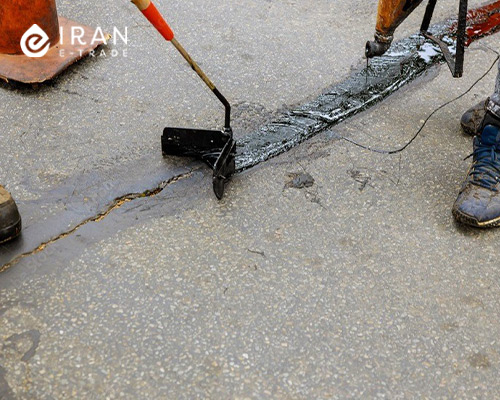
Bitumastic Suitable for Building Insulation
For effective building insulation, bituminous mastic is one of the reliable options. This mastic, with its high adhesion to various surfaces—especially concrete and metal—can prevent moisture and water penetration into walls and roofs.
Using asphalt mastic on foundations, retaining walls, and flat roofs increases the structure’s service life.
How to Use Bituminous Mastic
- The surface must be dry, clean, and free of dust.
- If using hot bitumastic, heat it to the appropriate temperature.
- Using a putty knife, trowel, or spray (depending on the type of mastic), apply the material to the surface, thoroughly filling all pores.
- Allow the mastic to dry and harden completely.
- If multiple layers are needed, make sure each previous layer is fully dry before applying the next.
- The thickness and durability of the bituminous mastic layer depend on the quality of the mastic used.
Important Safety Tips for Using Different Types of Bituminous Mastic
- When using hot mastic, always wear safety gloves and goggles.
- Ensure proper ventilation in enclosed spaces when applying solvent-based mastics.
- Avoid direct contact with skin and eyes.
- Store the mastic away from open flames and heat sources.
- Never expose bituminous mastic to direct heat, as this can cause carbonization and render it unusable.
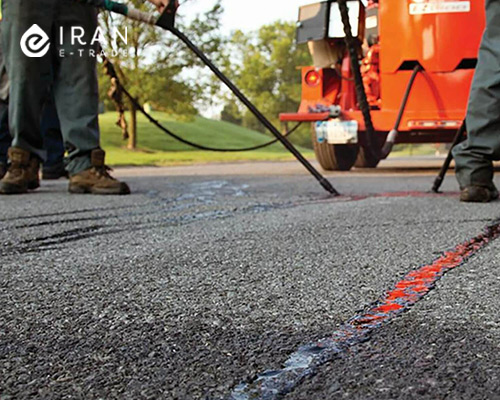
Frequently Asked Questions About Bituminous Mastic
To finish this article, here are answers to some common questions about what bituminous mastic is. These FAQs will help you make an informed decision when purchasing bituminous mastic or sealants.
For price inquiries on bituminous mastic and other petroleum products, please contact our experts at Iran ETrade.
What Is Asphalt Mastic?
Asphalt mastic, also known as bituminous mastic, is a type of mastic specifically used for filling joints and cracks in asphalt on roads.
Is Bitumastic Resistant to Water and Chemicals?
Yes, bitumastic—especially the hot type—has high resistance to water penetration and various chemicals.
What is the lifespan of bitumen mastic?
The lifespan of bitumen mastic varies between 5 to 15 years depending on environmental conditions and the method of application.
What is the specific gravity of bituminous mastic?
The specific gravity of bituminous mastic is usually between 0.05 and 1.5 grams per cubic centimetre.
What is bituminous mastic adhesive?
Bitumastic is a high-adhesion sealant made from a combination of bitumen and polymer materials, used for waterproofing and sealing various surfaces. It also plays a key role in increasing the durability of structures.
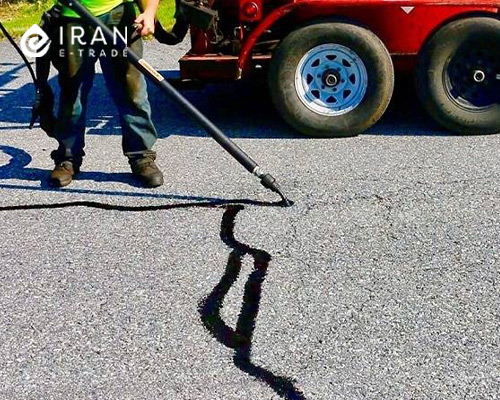
Source: baumerk, accuroof
Bitumen Price
- The Largest Bitumen Refineries In The World: Top 20 Refineries...
- What Is An Oil Lubricant: Types, Applications + Production
- What Is LPG: Properties + Uses Liquefied Petroleum Gas
- What Is Petroleum Paraffin: Types + Properties And Applications
- What is Petroleum Coke: Types + Applications
- What Is Mazut: Advantages, Applications + Hazards







